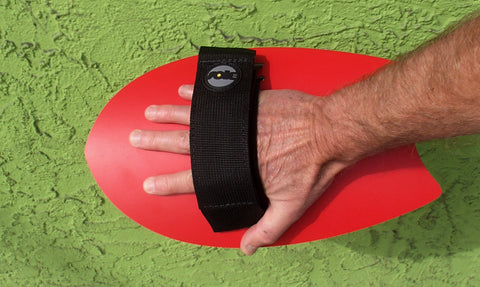Using Your Handplane
How do I Use a Handplane?
Before we get started on the basics of handplaning or bodysurfing, lets talk a little about the handplane itself. Common questions are: do I need one or two handplanes, which hand should I wear it on, which way is up, and how does it work.

Ambassadors and goofballs @overboarddad & @goodvibes_84
Most bodysurfers only use one plane, though some use two. With two handplanes strapped to your hands you may feel a little confined so we recommend using only one to begin with. The strap is fully adjustable. The concave side goes down and contacts the wave surface. Slip your fingers and back of your hand under the strap so that the thumb is on the outside of the strap and lays on the surface of the board with the fleshy part of the thumb up tight against the strap. The strap should be as snug as you can get it but still allow you to slide your hand in and out. If the plane comes off in the water you want to be able to slip it back on without re-adjusting the tension.

Which hand you wear it on will be whatever feels most comfortable to you. You probably have a dominant side of your body. If you were to walk sideways which foot or arm would you lead with? If you ride a skateboard or snow board, which foot would you put forward? Try the plane in both hands to see which is most natural to you. The wrist tether is removable from the strap. If the waves are small you might want to remove the tether (or at least remove it from your wrist) and try switching hands between waves to get a feel for whats best for you. The hand plane floats so you shouldn't have any trouble finding it if it comes off your hand.

Photo courtesy www.boatdesign.net
Using the principle of hydrodynamic lift, handplanes at speed work in the same manner as does a racing boat -the faster the boat moves the more of the boat is out of the water, reducing drag and allowing even greater speed. The the signature concave of a Sole Handplane increases these forces. As the handboard travels horizontally through the water, the concave of the board’s sole (bottom surface) forces the incoming water downward. This results in a reactionary force upward on the board and subsequently the bodysurfer. A handplane is thus somewhat different than a Boogie Board or surfboard that utilize a combination of floatation and hydrodynamic lift.

Sole Handplanes' signature concave in action
One of the great things about the design of our handplanes is their light weight and thin profile. This makes swimming with our handplane very natural. The other brands of planes are heavy and thick, making swimming difficult. Also the strap on our planes is the most comfortable in the industry. So go ahead and swim just as you would in a swimming pool or lake. Though when you get in the ocean you'll notice energy and forces outside of your control. That's when you'll really appreciate the design of our handplanes.
Now that you have your handplane on, lets go use it!! Check out our next article on the basics of bodysurfing.
See this link about more advanced techniques of bodysurfing.
Follow this link to learn more about wave anatomy, rip currents and some basic surfing rules.





The Sole Collective
Author